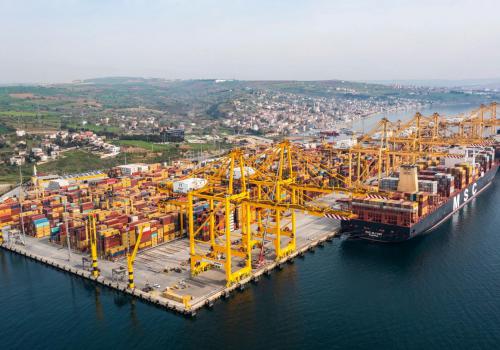Turkey’s export climate index in May climbed toward its highest level ever amid a significant improvement in demand conditions for the country’s manufacturing industry in main export markets, a survey showed Tuesday. The Manufacturing Export Climate Index increased to 58.4 from 56 in April, surpassing for the fourth consecutive month the threshold level of 50 that separates growth from contraction, according to a survey from the Istanbul Chamber of Industry (ISO) and London-based global data firm IHS Markit. The index marked one of the highest levels since records began in January 2002 and approached the all-time high of June 2006, a statement by the ISO said. The reading highlighted a strong rise in demand and "unprecedented increases in economic activity of some main export markets." In terms of demand for export products of the Turkish manufacturing sector, there is a table that varies from continent to continent, said Andrew Harker, economics director at IHS Markit. "Activity is growing strongly in Europe and North America. The increase is unprecedented in many countries due to loosening restrictions and successful vaccination campaigns. These developments were decisive in May when the export climate showed an improvement approaching record levels," Harker noted.
On the other hand, he said the continued strain in South America and Asia, where the COVID-19 outbreak has intensified, indicates that demand in these regions may be under pressure, at least for the near term. Turkey’s foreign sales achieved their second-best May ever as demand in Europe, the country’s top market, gathered pace. Exports surged 65.5% year-on-year to reach $16.6 billion last month, according to the Turkish Exporters' Assembly (TIM) data. Imports also jumped 54% on an annual basis to reach $20.6 billion for the month. January-May exports rose 38.3% year-on-year to $85.2 billion, the data showed, marking the best five-month performance to date. The preliminary reading showed output in the U.K. rose at the highest pace since 1998, while the growth was even faster in the U.S. The two economies account for about 13% of Turkish manufacturing exports. Record increases were also recorded in Ireland, the Netherlands and Austria. Russia, Poland and the Czech Republic also signaled stronger demand conditions by the middle of the second quarter.
May also saw an improvement in the eurozone's demand outlook. Economic growth in all eight eurozone countries, where PMI data is available, picked up momentum from April. Economic activity in Saudi Arabia accelerated from the previous month, notching its fastest increase in nearly three-and-a-half years. Meanwhile, growth fell to a three-month low in the United Arab Emirates (UAE) and an 11-month low in Qatar. Production in Egypt and Lebanon also declined. A recent outbreak in India led to a contraction in economic activity, ending an eight-month period of growth. Other Asian economies have also been negatively affected by the pandemic, leading to a slowdown in growth or a contraction in output in most economies. Strain continued in Latin America due to the effects of the outbreak. Output in Colombia fell sharply, while Mexico continued to contract. The demand conditions in Brazil continued to deteriorate slightly despite some signals pointing at a stabilization.
